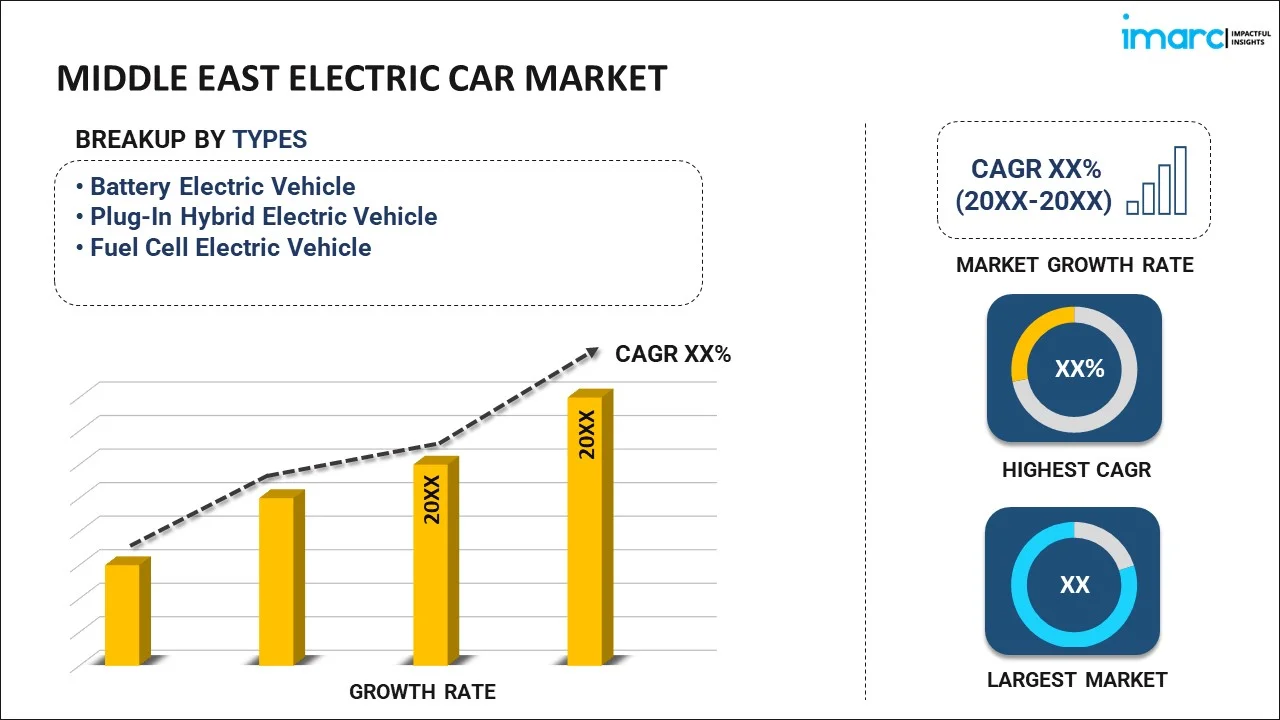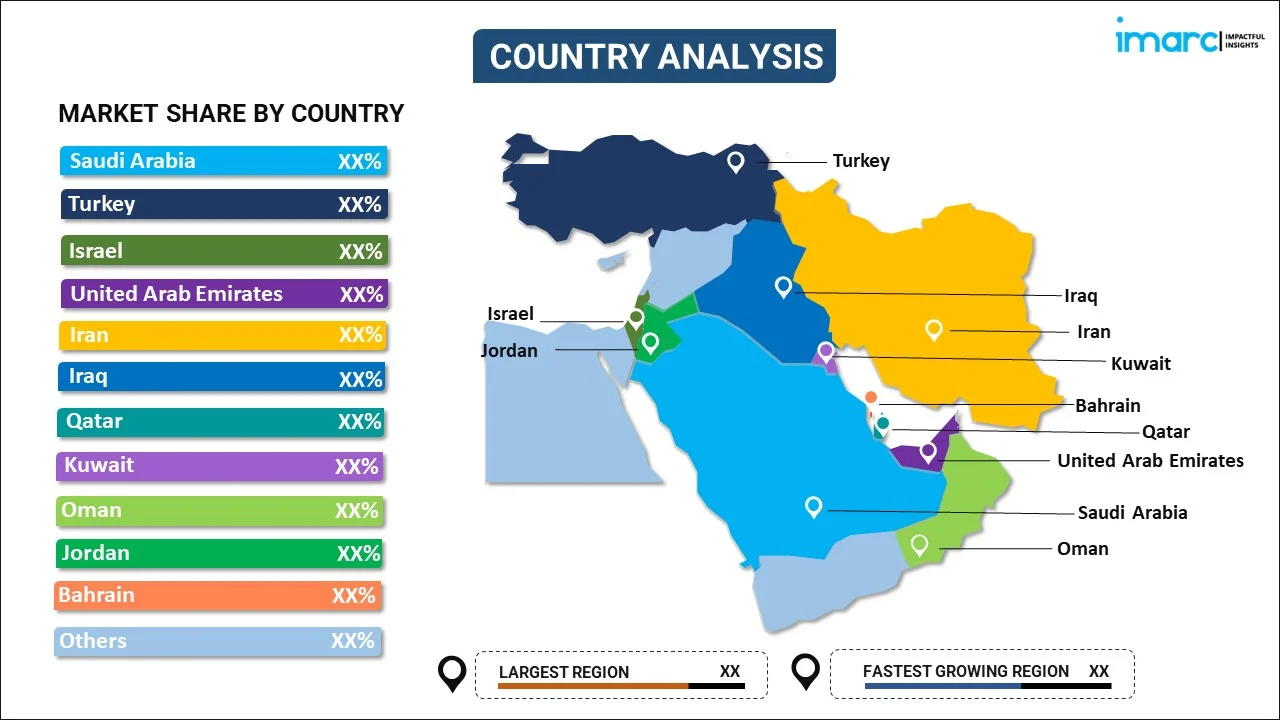
Middle East Electric Car Market Report by Type (Battery Electric Vehicle, Plug-In Hybrid Electric Vehicle, Fuel Cell Electric Vehicle), Vehicle Class (Mid-Priced, Luxury), Drive Type (Front Wheel Drive, Rear Wheel Drive, All-Wheel Drive), and Country 2025-2033
Market Overview:
Middle East electric car market size reached USD 6.8 Billion in 2024. Looking forward, IMARC Group expects the market to reach USD 14.5 Billion by 2033, exhibiting a growth rate (CAGR) of 8.1% during 2025-2033. The escalating demand for sustainable transportation, along with the widespread adoption of renewable energy sources, is primarily driving the regional market.
|
Report Attribute
|
Key Statistics
|
|---|---|
|
Base Year
|
2024 |
|
Forecast Years
|
2025-2033
|
|
Historical Years
|
2019-2024
|
| Market Size in 2024 | USD 6.8 Billion |
| Market Forecast in 2033 | USD 14.5 Billion |
| Market Growth Rate (2025-2033) | 8.1% |
An electric car utilizes electric motors and motor controllers to propel itself, drawing power from rechargeable batteries. Receiving energy from electricity, these vehicles, commonly known as EVs, play a significant role in promoting environmental cleanliness by producing no tailpipe pollutants. They exist in diverse forms, ranging from fully electric vehicles devoid of a gasoline engine to plug-in hybrid electric vehicles, which combine battery power with an internal combustion engine. Electric cars present numerous advantages, including reduced operational and maintenance costs, a noiseless driving experience, and the integration of advanced features such as regenerative braking and swift acceleration. Furthermore, these vehicles are integral components of a broader system that encompasses charging infrastructure, sophisticated battery technologies, and an evolving regulatory framework. Embraced by consumers, governments, and businesses worldwide, electric cars are poised to reshape the transportation landscape.
Middle East Electric Car Market Trends:
The Middle East's electric car market is experiencing a transformative shift as it emerges as a focal point in the region's efforts to embrace sustainable transportation. With a growing emphasis on reducing carbon footprints and mitigating the environmental impact of traditional combustion engines, electric cars have gained significant traction across countries in the Middle East. Furthermore, governments and businesses alike are actively promoting electric vehicles (EVs) as part of comprehensive strategies to diversify energy sources and address climate change concerns, which is positively influencing the market growth. This push is complemented by a developing charging infrastructure, providing the necessary support for the widespread adoption of EVs. The Middle East electric car market reflects a diverse landscape, featuring a range of electric vehicle models from various manufacturers. Moreover, consumer interest is on the rise, driven not only by environmental consciousness but also by the cost savings associated with the operational efficiency of electric cars. Additionally, government incentives, such as subsidies and tax benefits, further propel the market's growth. As the region embraces the future of transportation, the Middle East electric car market will be positioned as a dynamic and influential player in the shift towards sustainable mobility over the forecasted period.
Middle East Electric Car Market Segmentation:
IMARC Group provides an analysis of the key trends in each segment of the market, along with forecasts at the regional and country levels for 2025-2033. Our report has categorized the market based on type, vehicle class, and drive type.
Type Insights:

- Battery Electric Vehicle
- Plug-In Hybrid Electric Vehicle
- Fuel Cell Electric Vehicle
The report has provided a detailed breakup and analysis of the market based on the type. This includes battery electric vehicle, plug-in hybrid electric vehicle, and fuel cell electric vehicle.
Vehicle Class Insights:
- Mid-Priced
- Luxury
A detailed breakup and analysis of the market based on the vehicle class have also been provided in the report. This includes mid-priced and luxury.
Drive Type Insights:
- Front Wheel Drive
- Rear Wheel Drive
- All-Wheel Drive
The report has provided a detailed breakup and analysis of the market based on the drive type. This includes front wheel drive, rear wheel drive, and all-wheel drive.
Country Insights:

- Saudi Arabia
- Turkey
- Israel
- United Arab Emirates
- Iran
- Iraq
- Qatar
- Kuwait
- Oman
- Jordan
- Bahrain
- Others
The report has also provided a comprehensive analysis of all the major regional markets, which include Saudi Arabia, Turkey, Israel, United Arab Emirates, Iran, Iraq, Qatar, Kuwait, Oman, Jordan, Bahrain, and Others.
Competitive Landscape:
The market research report has also provided a comprehensive analysis of the competitive landscape in the market. Competitive analysis such as market structure, key player positioning, top winning strategies, competitive dashboard, and company evaluation quadrant has been covered in the report. Also, detailed profiles of all major companies have been provided. Some of the key players include:
- BYD Auto Industry Co. Ltd
- Geely Auto Group
- M Glory Holding
- Tesla
(Please note that this is only a partial list of the key players, and the complete list is provided in the report.)
Middle East Electric Car Market Report Coverage:
| Report Features | Details |
|---|---|
| Base Year of the Analysis | 2024 |
| Historical Period | 2019-2024 |
| Forecast Period | 2025-2033 |
| Units | Billion USD |
| Scope of the Report | Exploration of Historical Trends and Market Outlook, Industry Catalysts and Challenges, Segment-Wise Historical and Future Market Assessment:
|
| Types Covered | Battery Electric Vehicle, Plug-In Hybrid Electric Vehicle, Fuel Cell Electric Vehicle |
| Vehicle Classes Covered | Mid-Priced, Luxury |
| Drive Types Covered | Front Wheel Drive, Rear Wheel Drive, All-Wheel Drive |
| Countries Covered | Saudi Arabia, Turkey, Israel, United Arab Emirates, Iran, Iraq, Qatar, Kuwait, Oman, Jordan, Bahrain, Others |
| Companies Covered | BYD Auto Industry Co. Ltd, Geely Auto Group, M Glory Holding, Tesla, etc. |
| Customization Scope | 10% Free Customization |
| Post-Sale Analyst Support | 10-12 Weeks |
| Delivery Format | PDF and Excel through Email (We can also provide the editable version of the report in PPT/Word format on special request) |
Key Questions Answered in This Report:
- How has the Middle East electric car market performed so far and how will it perform in the coming years?
- What has been the impact of COVID-19 on the Middle East electric car market?
- What is the breakup of the Middle East electric car market on the basis of type?
- What is the breakup of the Middle East electric car market on the basis of vehicle class?
- What is the breakup of the Middle East electric car market on the basis of drive type?
- What are the various stages in the value chain of the Middle East electric car market?
- What are the key driving factors and challenges in the Middle East electric car?
- What is the structure of the Middle East electric car market and who are the key players?
- What is the degree of competition in the Middle East electric car market?
Key Benefits for Stakeholders:
- IMARC’s industry report offers a comprehensive quantitative analysis of various market segments, historical and current market trends, market forecasts, and dynamics of the Middle East electric car market from 2019-2033.
- The research report provides the latest information on the market drivers, challenges, and opportunities in the Middle East electric car market.
- Porter's five forces analysis assist stakeholders in assessing the impact of new entrants, competitive rivalry, supplier power, buyer power, and the threat of substitution. It helps stakeholders to analyze the level of competition within the Middle East electric car industry and its attractiveness.
- Competitive landscape allows stakeholders to understand their competitive environment and provides an insight into the current positions of key players in the market.
Need more help?
- Speak to our experienced analysts for insights on the current market scenarios.
- Include additional segments and countries to customize the report as per your requirement.
- Gain an unparalleled competitive advantage in your domain by understanding how to utilize the report and positively impacting your operations and revenue.
- For further assistance, please connect with our analysts.
 Request Customization
Request Customization
 Speak to an Analyst
Speak to an Analyst
 Request Brochure
Request Brochure
 Inquire Before Buying
Inquire Before Buying




.webp)




.webp)












